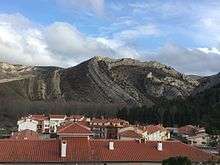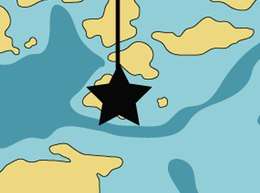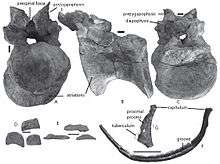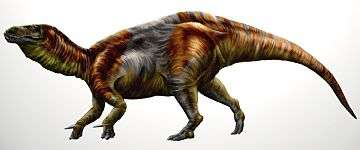Camarillas Formation
The Camarillas Formation is a geological formation in the Teruel Province of Aragón, Spain whose strata date back to the Early Cretaceous (Barremian stage). The sandstones, mudstones and conglomerates of the formation, that due to syn-sedimentary faulting varies greatly in thickness from 300 to 800 metres (980 to 2,620 ft), were deposited in fluvial, deltaic and lacustrine environments.
| Camarillas Formation Stratigraphic range: Barremian ~130–125 Ma | |
|---|---|
 The Camarillas Formation crops out in the geological park of Aliaga | |
| Type | Geological formation |
| Underlies | Artoles Formation |
| Overlies | El Castellar Formation |
| Thickness | 300–800 m (980–2,620 ft) |
| Lithology | |
| Primary | Sandstone, mudstone |
| Other | Conglomerate |
| Location | |
| Coordinates | 40.7°N 0.9°W |
| Approximate paleocoordinates | 30.7°N 9.2°E |
| Region | Teruel, Aragón |
| Country | |
| Extent | Galve Basin |
| Type section | |
| Named for | Camarillas |
| Named by | Canérot et al. |
| Year defined | 1982 |
 Camarillas Formation (Spain)  Camarillas Formation (Aragon) | |
The formation was deposited in the Galve Sub-basin of the Maestrazgo Basin in central-eastern Spain. During deposition, Iberia was an island, separated by seas from North Africa and France. Underlying the Camarillas Formation is the also highly fossiliferous El Castellar Formation and the Artoles Formation rests on top of the formation.[1]
The Camarillas Formation has provided a rich fossil assemblage of fossils of mammals, snakes, turtles, crocodylians, fish, dinosaurs and their eggs. Various tracksites of families of dinosaurs exist in the formation.
Dinosaur remains have been recovered from the formation.[2]
Description

The Camarillas Formation was first formally defined by Canérot et al. in 1982 and later redefined by Salas (1987).[3]
Both Camarillas and Galve are in the Galve Sub-basin, a section of the Aliaga Basin, in the Iberian Range. All these basins were formed during the Permian–Triassic, when the main faults were active, and they are filled with Mesozoic–Quaternary sediments.
The Upper Permian to Upper Jurassic deposits at the site of the Camarillas Formation are all of continental origin. In a second extensional stage during the Late Jurassic to Early Cretaceous, the Atlantic and the Bay of Biscay opened, and the Iberian Peninsula rotated from left to right. At this time, the sediments were marine or showed the influence of the sea, as shown in the deposits of the Higuerueles and Villar del Arzobispo Formations in the Galve Sub-basin. Finally, during the Early Cretaceous and Oligocene–Miocene there were compressive phases with tectonic inversion and formation of continental basins.[4]
Camarillas Formation, in beds of similar age to the La Maca outcrop in the Galve area where the remains of an iguanodontid dinosaur have been found. The Camarillas fossil site is in light brown clay and limestone rocks with fossil wood remains. The sedimentology is similar to that described in the Galve area, because the Camarillas Formation shows scarcely any lateral variations in facies within the Galve Sub-basin.
The Camarillas Formation sandstone is fluviatile, and four groups of paleochannels are distinguished, the first towards the bottom of the succession. These channels become thinner towards the top, and this was interpreted by Díaz and Yébenes (1987) as evidence that there was an alluvial fan with a multichannel system. The lithology of the deposits which fill these channels and their geometry are typical of low-sinuosity channels. Towards the top of the Camarillas Formation, there is a predominance of deltaic fan deposits with marked marine influence. Nevertheless, Soria (1997) mentioned that she found no facies association whose evolution and geometry suggested a well developed deltaic system.[5]
The formation spreads across the Camarillas graben and the Remenderuelas half-graben.
Fossil content
The Camarillas Formation has provided a rich fossil assemblage comprising dinosaurs, crocodiles, snakes, turtles, fish and mammals. Several new species were described from the formation, among others the mammals Galveodon nannothus, Eobaatar hispanicus, Crusafontia cuencana, Lavocatia alfambrensis and Parendotherium herreroi, the turtle Galvechelone lopezmartinezae and the crocodyloform Bernissartia fagesii.
Newly described dinosaurs include Iguanodon galvensis, Delapparentia turolensis, Gideonmantellia amosanjuanae and Camarillasaurus cirugedae, named after the formation.
The following fossils are reported from the formation:[7]
- Fuente Arnar outcrop
- near Camarillas village, Teruel Province, Aragón, NE Spain
- Type horizon: Light brown clay and limestone beds, in which fossil wood remains are common, of the Camarillas Formation, lower Barremian, Lower Cretaceous
- Ceratosaurs
- Eggs
- Cerrada Roya mine[9]
- Mammals
- Turtles
- Galvechelone lopezmartinezae
- Crocodyloforms
- Snakes
- Dinosaurs
- Pterosaurs
- Fish
- Polyacrodus parvidens
- Lonchidion microselachos
- Rhinobatos sp.
- San Cristóbal 1[11]
- Poca[12]
- Mammals
- Turtles
- Snakes
- Paramacellodidae indet.
- Dinosaurs
- Fish
- Polyacrodus parvidens
- La Maca 3[13]
- Dinosaurs
- Other reptiles
- Fish
- Invertebrates
- Poyales Barranco Hondo[15]
- Dinosaurs
- Other reptiles
- Partida Poyales[16]
- Pajar Julián Paricio 2[17]
- Sharks
- Dinosaurs
- La Maca[18]
- Elliptio galvensis
Correlation
| Ma | Age | Paleomap \ Basins | Cantabrian | Olanyà | Cameros | Maestrazgo | Oliete | Galve | Morella | South Iberian | Pre-betic | Lusitanian | ||
|---|---|---|---|---|---|---|---|---|---|---|---|---|---|---|
| 100 | Cenomanian |  | La Cabana | Sopeira | Utrillas | Mosquerela | Caranguejeira | |||||||
| Altamira | Utrillas | |||||||||||||
| Eguino | ||||||||||||||
| 125 | Albian | Ullaga - Balmaseda | Lluçà | Traiguera | ||||||||||
| Monte Grande | Escucha | Escucha | Jijona | |||||||||||
| Itxina - Miono | ||||||||||||||
| Aptian | Valmaseda - Tellamendi | Ol Gp. - Castrillo | Benassal | Benassal | Olhos | |||||||||
| Font | En Gp. - Leza | Morella/Oliete | Oliete | Villaroya | Morella | Capas Rojas | Almargem | |||||||
| Patrocinio - Ernaga | Senyús | En Gp. - Jubela | Forcall | Villaroya | Upper Bedoulian | Figueira | ||||||||
| Barremian | Vega de Pas | Cabó | Abejar | Xert | Alacón | Xert | Huérguina | Assises | ||||||
| Prada | Artoles | Collado | Moutonianum | Papo Seco | ||||||||||
| Rúbies | Tera Gp. - Golmayo | Alacón/Blesa | Blesa | Camarillas | Mirambel | |||||||||
| 150 | Hauterivian |  | Ur Gp. - Pinilla | Llacova | Castellar | Tera Gp. - Pinilla | Villares | Porto da Calada | ||||||
| hiatus | ||||||||||||||
| Huerva | Gaita | |||||||||||||
| Valanginian | Villaro | Ur Gp. - Larriba | Ped Gp. - Hortigüela | |||||||||||
| Ped Gp. - Hortigüela | Ped Gp. - Piedrahita | |||||||||||||
| Peñacoba | Galve | Miravetes | ||||||||||||
| Berriasian |  | Cab Gp. - Arcera | Valdeprado | hiatus | Alfambra | |||||||||
| TdL Gp. - Rupelo | Arzobispo | hiatus | Tollo | |||||||||||
| On Gp. - Huérteles Sierra Matute | ||||||||||||||
| Tithonian | Lastres | Tera Gp. - Magaña | Higuereles | Tera Gp. - Magaña | Lourinhã | |||||||||
| Arzobispo | ||||||||||||||
| Ágreda | ||||||||||||||
| Legend | Major fossiliferous, oofossiliferous, ichnofossiliferous, coproliferous, minor formation | |||||||||||||
| Sources | ||||||||||||||
Gallery
See also
- List of dinosaur-bearing rock formations
- Tremp Formation
- Escucha Formation
- La Huérguina Formation
- Villar del Arzobispo Formation
References
- Herrero Gascón & Pérez Lorente, 2009, p.68
- Weishampel et al., 2004, pp. 556-563
- Royo Torres et al., 2013, p.5
- Sánchez Hernández & Benton, 2014, p.582
- Sánchez Hernández & Benton, 2014, p.583
- Camarillas Formation at Fossilworks.org
- Moreno Azanza et al., 2014
- Cerrada Roya Mine at Fossilworks.org
- Canudo & Cuenca Bescós, 1996, p.217
- San Cristóbal 1 at Fossilworks.org
- Poca at Fossilworks.org
- La Maca 3 at Fossilworks.org
- Ruiz Omeñaca, 2013, p.87
- Poyales Barranco Hondo at Fossilworks.org
- Partida Poyales at Fossilworks.org
- Pajar Julián Paricio 2 at Fossilworks.org
- La Maca 2 at Fossilworks.org
Bibliography
- Moreno Azanza, M.; J.I. Canudo, and J.M. Gasca. 2014. Spheroolithid eggshells in the Lower Cretaceous of Europe. Implications for eggshell evolution in ornithischian dinosaurs. Cretaceous Research 51. 75-87. Accessed 2019-10-10.
- Sánchez Hernández, B., and M.J. Benton. 2014. Filling the ceratosaur gap: A new ceratosaurian theropod from the Early Cretaceous of Spain. Acta Palaeontologica Polonica 59. 581–600. Accessed 2019-10-10.

- Navarrete, Rocío; Carlos L. Liesa; Ana R. Soria, and Juan P. Rodríguez López. 2013. Actividad de fallas durante el depósito de la Formación Camarillas(Barremiense) en la subcuenca de Galve (E de España) - Fault activity during the deposit of the Barremian Camarillas Formation in the Galve subbasin (E Spain). Geogaceta 53. 61–64. Accessed 2019-10-10.
- Ruiz Omeñaca, J.I. 2011. Delapparentia turolensis nov. gen et sp., un nuevo dinosaurio iguanodontoideo (Ornithischia: Ornithopoda) en el Cretácico Inferior de Galve - Delapparentia turolensis nov. gen et sp., a new iguanodontoid dinosaur (Ornithischia: Ornithopoda) from the Lower Cretaceous of Galve (Spain). Estudios Geológicos 67. 83-110. Accessed 2019-10-10.
- Herrero Gascón, Jesús, and Félix Pérez Lorente. 2009. Aportaciones de un nuevo yacimiento de icnitas saurópodas de la Formación Camarillas (Barremiense inferior, Galve, Teruel) - The contributions of a sauroropod footprint new site. Camarillas Formation (lower Barremian, Galve, Teruel). Geogaceta 46. 67–70. Accessed 2019-10-10.
- Royo Torres, Rafael; Luis Mampel, and Luis Alcalá. 2009. Icnitas de dinosaurios del yacimiento San Cristóbal 3 de la Formación Camarillas en Galve (Teruel, España) - Dinosaur footprints of the San Cristóbal 3 tracksite from Camarillas Formation in Galve (Teruel, Spain). Geogaceta 53. 5–8. Accessed 2019-10-10.
- Weishampel, David B.; Peter Dodson, and Halszka Osmólska (eds.). 2004. The Dinosauria, 2nd edition, 1–880. Berkeley: University of California Press. Accessed 2019-02-21.ISBN 0-520-24209-2
- Canudo, José Ignacio, and Gloria Cuenca Bescós. 1996. Two new mammalian teeth (Multituberculata and Peramura) from the Lower Cretaceous (Barremian) of Spain. Cretaceous Research 17. 215–228. Accessed 2019-10-10.
Further reading
- L. Alcalá, M. G. Lockley, A. Cobos, L. Mampel, and R. Royo Torres. 2016. Evaluating the dinosaur track record: an integrative approach to understanding the regional and global distribution, scientific importance, preservation, and management of tracksites. In P. L. Falkingham, D. Marty, & A. Richter (eds.), Dinosaur Tracks: The Next Steps 100-116
- F. J. Verdú, R. Royo Torres, A. Cobos and L. Alcalá. 2015. Perinates of a new species of Iguanodon (Ornithischia: Ornithopoda) from the lower Barremian of Galve (Teruel, Spain). Cretaceous Research 56:250-264
- Verdú, Francisco Javier; Rafael Royo Torres, and Alberto Cobos. 2014. Fósiles de ornitópodo de la Formación Camarillas (Barremiense inferior) de Teruel (España) - Ornithopod fossils from the Camarillas Formation (lower Barremian) of Teruel (Spain), 120-123. XII Encuentro Jóvenes Investigadores, at Sobrarbe (Oltaña). Accessed 2019-10-10.
- B. Sánchez Hernández, M. J. Benton, and D. Naish. 2007. Dinosaurs and other fossil vertebrates from the Late Jurassic and Early Cretaceous of the Galve area, NE Spain. Palaeogeography, Palaeoclimatology, Palaeoecology 249:180-21
- J. I. Ruiz Omeñaca, J. I. Canudo, and P. Infante. 2005. Presencia de un posible alosáurido (Dinosauria: Theropoda) en el Cretácico Inferior (Barremiense inferior) de La Maca 3 (Galve, Teruel) [Presence of a possible allosaurid (Dinosauria: Theropoda) in the Lower Cretaceous (lower Barremian) of La Maca 3 (Galve, Teruel)]. In E. Bernáldez, E. Mayoral, & A. Guerreiro dos Santos (eds.), XXI Jornadas de la Sociedad Española de Paleontología. Gestión e Investigación de la Paleontología en el Siglo XXI, Sevilla 117-118
- X. Pereda Suberbiola, P. M. Galton, J. I. Ruiz-Omeñaca and J. I. Canudo. 2005. Dermal spines of stegosaurian dinosaurs from the Lower Cretaceous (Hauterivian-Barremian) of Galve (Teruel, Aragón, Spain). Geogaceta 38:35-38
- J. I. Ruiz Omeñaca and J. I. Canudo. 2003. Dinosaurios (Saurischia, Ornithischia) en el Barremiense (Cretácico Inferior) de la península Ibérica [Dinosaurs (Saurischia, Ornithischia) in the Barremian (Lower Cretaceous) of the Iberian peninsula]. In F. Pérez Lorente (ed.), Dinosaurios y Otros Reptiles Mesozóicos de España 269-312
- J. I. Ruiz Omeñaca, J. I. Canudo, and G. Cuenca-Bescós. 1998. Sobre las especies de Iguanodon (Dinosauria, Ornithischia) encontradas en el Cretácico inferior de España [On the species of Iguanodon (Dinosauria, Ornithischia) found in the Lower Cretaceous of Spain]. Geogaceta 24:275-278
- J. I. Canudo, O. Amo, G. Cuenca Bescós, A. Meléndez, J. I. Ruiz Omeñaca and A. R. Soria. 1997. Los vertebrados del Tithónico-Barremiense de Galve (Teruel, España) [The Tithonian-Barremian vertebrates of Galve (Teruel, Spain)]. Cuadernos de Geologia Ibérica 23:209-241
- J. L. Sanz, A. D. Buscalioni, M.-L. Casanovas and J.-V. Santafé. 1987. Dinosaurios del Cretácico inferior de Galve (Teruel, España) [Dinosaurs from the Lower Cretaceous of Galve (Teruel, Spain)]. Estudios Geologicos, Volumen Extraordinario Galve-Tremp 45-64


